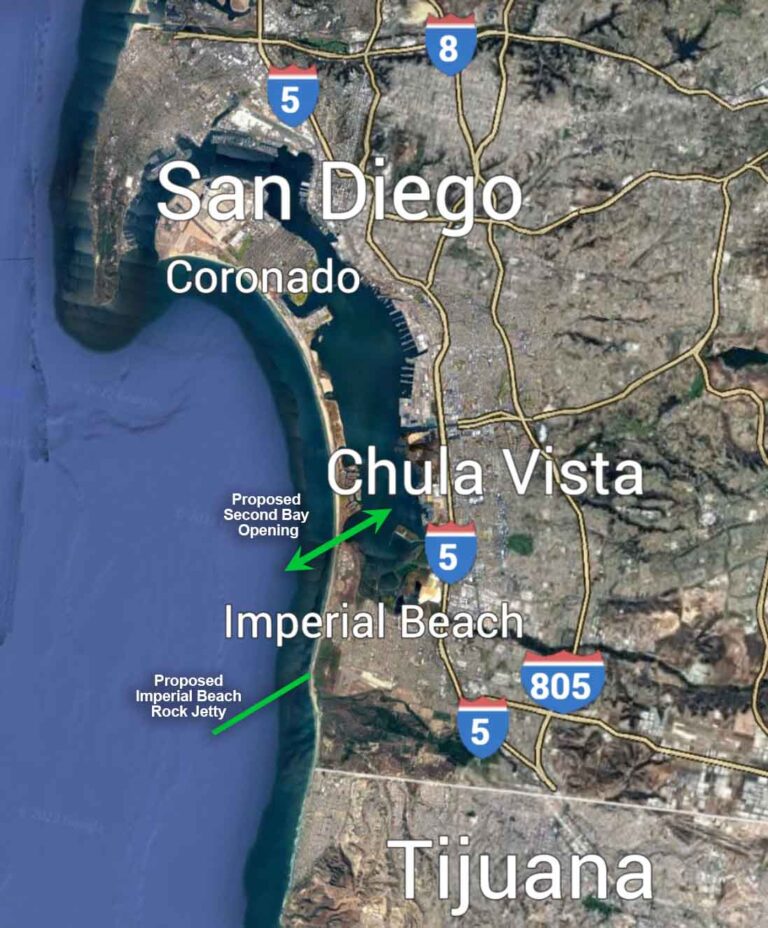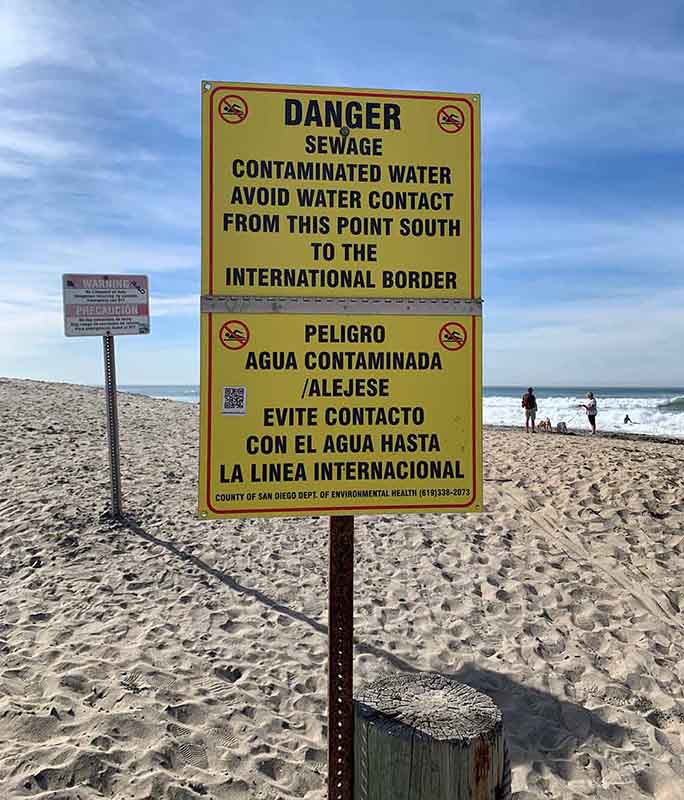Submitted by George Mullen
Build a Breakwater to Send it Out to Sea
Tijuana sewage has been spoiling the beaches and outdoor life of Americans in Imperial Beach and Coronado for decades. Our elite U.S. Navy SEAL special forces regularly train in these same polluted waters. And many people and wildlife are routinely exposed and sickened. This is an unacceptable ongoing environmental disaster.
Tijuana’s population explosion coupled with its antiquated (and underfunded) sewage infrastructure has made this problem significantly worse. The recent $494 million agreement with the U.S. pledging $350 million and Mexico pledging $144 million to replace the failing sewage treatment facilities in Tijuana will hopefully help. But for a city as large as Tijuana (pop 2.2 million), this will not be nearly enough money to solve the problem.
We are hoping for the best with this agreement, but recognize we need to prepare for the worst.
Absent a true solution (with sufficient ongoing funding) to handle Tijuana’s sewage, our best option is what I call the TJ Dilution Solution. It may prove to be the critical extra layer of protection that we need.
If we mix a single drop of cyanide into a tablespoon of water, the cyanide will remain lethal. However, if we mix that same drop of cyanide into 500 billion gallons of water, it will be rendered harmless. This is the central principle of the Dilution Solution.
Tijuana’s sewage primarily flows downhill into the Tijuana River which exits into the beach waters of the Pacific Ocean. Likewise, Tijuana’s Punta Bandera Wastewater Treatment Plant six miles to the south is estimated to be releasing 35 million gallons of raw sewage per day into these same beach waters.
The swell conditions (known as transboundary flows) then pushes this sewage through the shallow coastal waters northward into United States territorial waters.
This sewage hugs the coast and quickly reaches the shallow beach waters of the U.S. National Wildlife Refuge, Imperial Beach, U.S. Navy SEAL Silver Strand Training Complexes, California Silver Strand State Beach, and Coronado.
With beach water depths of one to eight feet, there is minimal opportunity for dilution of this sewage. As a result, these beaches are routinely closed with people and wildlife being sickened. The illnesses run the gamut in severity from mild to life-threatening.
Is there any other option that could help solve this problem?
Yes, there is.
By building a 2.7 mile-long rock jetty / breakwater into the Pacific Ocean at the south end of Imperial Beach, we can physically block Tijuana’s sewage from flowing northward into shallow U.S. waters. The sewage would instead be pushed back and outward 2.7 miles into ocean depths of 100 plus feet.
With the sewage redirected into exponentially larger quantities of seawater, dilution of the Tijuana pollution-poison becomes more viable and quicker to accomplish. Daily tidal pulls (driven by moon cycles) will also help pull much of this sewage even further offshore and into far deeper waters.

If you look at a water depth chart you will see that beyond 100 feet, depths quickly descend to 500 feet, and then to 4,000 plus feet. A gallon of sewage mixing into 4,000 feet of water will be diluted at an exponentially faster rate than in two feet of water, just like that drop of cyanide would.
Will some of this sewage (now mixing in exponentially larger quantities of water further offshore) still make its way into Imperial Beach and Coronado waters? Possibly, but it will be minimal in comparison to what is happening today, plus it will be far more diluted and thus significantly less toxic.
The 1.5 mile-long Zuñiga Shoals Jetty at the mouth of San Diego Bay and the two 4,000 foot Mission Bay Jetties are local examples of what we are proposing. Iraq’s Faw Breakwater in the Persian Gulf is the longest in the world at 9.1 miles and is perhaps the best example. To see the magnitude of what is possible to build in the open ocean, look at Dubai’s Palm Jumeirah.
In our case, we are proposing a straight rock jetty. This is not rocket science, we have the experience and technology to accomplish this. The new wave-dissipating XBloc technology used at the recent Calais Port expansion may prove to be the perfect fit for our project.
Our proposed jetty would stretch 2.7 miles from the south end of Imperial Beach (just north of the Tijuana River exit) toward the submerged buoys at the U.S. / Mexico border water line. This southwesterly jetty angle will force the Tijuana sewage into 100 foot plus waters while minimizing the impact on wave swells and beach breaks for Imperial Beach surfers.
The jetty placement will be far south of the main Imperial Beach tourist areas and won’t even be visible from them. And there is no fishing or (legal) boating activity in the area to be affected either.
The beaches of Imperial Beach and Coronado are our tablespoon, if you will. We need to keep the Tijuana sewage-poison away from our tablespoon, and instead direct it into the 500 billion gallons of seawater that lay offshore.
San Diego’s Point Loma Wastewater Treatment Plant treats approximately 175 million gallons of raw sewage per day. After treatment, the wastewater is discharged into the ocean via a pipe that extends 4.5 miles into the ocean and released at a depth of 320 feet. Though treated waste has reduced toxin levels, it is still toxic. The principle is the same though — get the pollution-poison offshore and mixed into the 500 billion gallons of seawater in order to dilute it.
The proposed Imperial Beach Jetty would ideally be constructed in conjunction with a Second Opening to San Diego Bay. Why? Because an eventual second bay opening (long-needed for national security and environmental purposes) will necessitate the nearby construction of two additional breakwaters into the Pacific Ocean, in order to enable the safe passage of entering and exiting ships.

The three breakwaters should be studied as a group by the Army Corps of Engineers in order to measure their combined impact on the transboundary sewage flows northward, as well their impact on preventing coastal erosion.
The three breakwaters also present a unique opportunity to build a large-scale green electricity plant via wave-energy production as proven by Spain’s innovative Mutriku Wave Energy Plant. Wave-energy turbines could be integrated into the three breakwaters and generate a significant multiple of Mutriku’s output.
The electricity these wave-energy turbines produce could then help power the adjacent cities of Imperial Beach and Coronado, as well as the adjacent U.S. Naval bases.
As far as cost and time of this project, the Faw Breakwater (completed in 2020) took five years to complete at a cost of $591 million. Based on the proposed Imperial Beach Jetty being less than 30 percent of Faw’s length, we can extrapolate a rough estimate of two years and $178 million. Note that this estimate represents only 36% of the $494 million that the U.S. and Mexico have budgeted to solve the Tijuana sewage problem.
The big question is, where would this $494 million be best spent in order to successfully protect America and Americans from Tijuana’s sewage? And what other parties have a vested self-interest in the TJ Dilution Solution?
First, the wave-energy revenue produced from the proposed breakwaters could be used to help offset the jetty construction costs. Likewise, the green-electricity component of this project should gain the full support of the Biden Administration and Department of Energy — perhaps leading to direct federal funding assistance.
Second, because our indispensable Navy SEALs are regularly training submerged in these waters, the U.S. Navy has a significant interest in keeping these waters clean and sewage-free. The U.S. Department of Defense spent over $36 billion in San Diego County alone in fiscal 2022. The DOD has the ability (and self-interest here) to add a budget line-item to help solve this critical SEAL training issue.
Third, noting that the proposed Imperial Beach Jetty would become the most southwesterly point in the continental United States, it may be an ideal technological location platform point (radar, sonar, tracking, listening) for the U.S. Navy, DEA, Customs and Border Patrol, and other agencies. These entities should also be willing funding partners.
As a San Diego native and long-time surfer, I have been aware of the Tijuana sewage problem since I was a teenager. It was a deterrent to visiting and surfing Imperial Beach when I was young, and it is even more so today. And this problem is now impacting Coronado and the beaches in front of the world-famous Hotel Del Coronado.

Imperial Beach and Coronado are blessed with some of the most beautiful beaches in the world. And, yet, they are increasingly being rendered unusable for much of the year. This situation is unfair to our citizens, Navy SEALs, tourists, wildlife, and the cohesiveness of the San Diego / Tijuana region.
Recognizing that Tijuana’s population will continue its rapid growth rate, this sewage problem is only going to worsen over time. We must address this problem now with every available option at our disposal.
The TJ Dilution Solution may be the critical missing piece to this puzzle. It merits a serious conversation.
Submitted by George Mullen
The TJ Dilution Solution was originally introduced via publication in Times of San Diego on February 14, 2023.
George Mullen Biography, Principal of StudioRevolution




